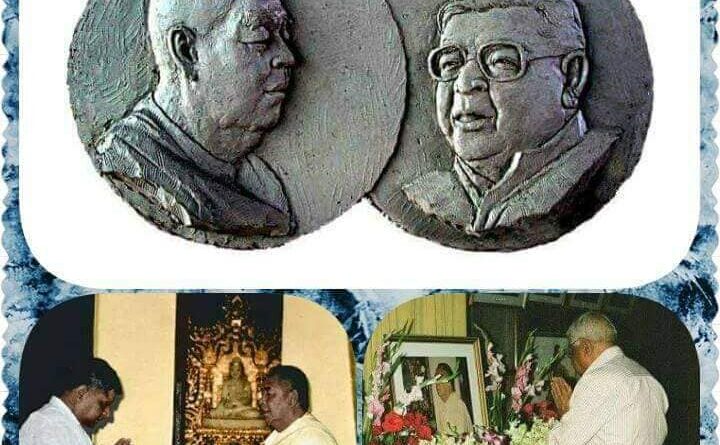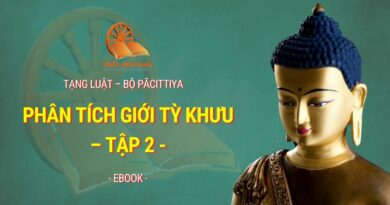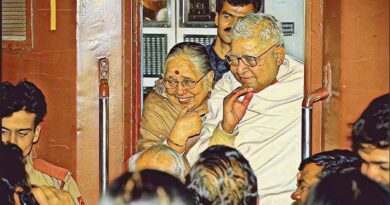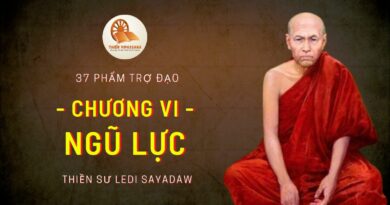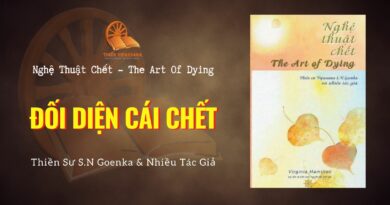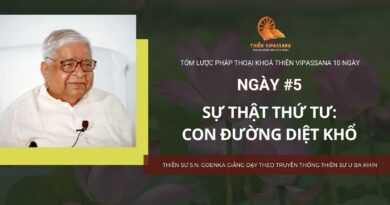Gratitude To Sayagyi U Ba Khin – S.N. Goenkaji
This is a very important year because it marks the centenary of the great lay saint, Sayagyi U Ba Khin. To honor his memory we have to work hard.
We may make many memorials and monuments; there is nothing wrong in doing so. But the biggest monument is the individual meditator. Each of you is a monument. Develop yourself to such an extent in Dhamma that people know, Here is a Vipassana meditator who received Dhamma from Sayagyi U Ba Khin and his tradition.
Oh, how it changes people! How this person has progressed!
This is the best memorial one can establish.
And everyone should do that in one’s own interest. You are not doing Sayagyi U Ba Khin a favor by developing yourself in Dhamma.
Of course, you are making an effort to show your gratitude toward him, but at the same time you are making an effort to encourage people to walk on the path and help themselves become liberated.
There are two important things that each meditator in this tradition ought to do.
1) One must do one’s best to get established in pure Dhamma, which means:
abstaining from unwholesome activities,
performing wholesome activities, and
purifying the mind (the totality of the mind, not just the surface). Each meditator should ask, how can I work to establish myself in Dhamma and become a good example for others?
2) Each should do is try to help fulfill the vision, the noble mission, of Sayagyi: to work so that the Dhamma may be re-established in India, the country of its origin, and spread from there around the world.
The best commemoration of this saintly person is to become established in Dhamma oneself and then to work so that more and more people come to the Path.
People must know that there is a way involving no blind faith nor blind belief: if you work, you achieve the result. Once you get the result, you develop faith; you believe in it.
First, apply yourself; work on it. You will certainly get results. Then naturally you will develop faith; and you will take the next step, and the next, until you reach the final goal.
Work hard and see.
At times the Buddha used to go to a certain community involved in rites, rituals and philosophical beliefs.
Their aim was to get out of the cycle of birth and death, to get out of misery.
Is this your aim? he would ask. Yes.
Then give me seven days of your life, he used to say. Give me just seven days of your life.
I am not here to make you my disciple.
I am not interested in that.
I am not here to snatch you from your old guru.
I am not interested in that.
I am not here to tell you
that you must believe what I say.
I am not interested in that. Give a trial and see what you get. Give a trial.
This is the Dhamma way.
If people know that there is a path, if they hear there is a path and they give a trial, they will achieve the result.
It is a result-oriented technique.
You do not work now to gain something only after death.
Some benefits should come right now.
You should know, Even now I am progressing, progressing, progressing.
After death as well, I will certainly progress. If there is no result now, it is not Dhamma.
This is how it spread at the time of Buddha.
And this is how my Dhamma father wanted it to spread.
He said to me: There are people with very good parami in India and around the world.
First you have to begin in India.
As soon as you go there, those people will come.
You won’t have to say to them,Come, come, come. They will come. When they hear the word Vipassana, something will start happening in them and they will think: Oh, I’d better give a trial. I’d better go. It will happen. And likewise there are similar people around the world with good parami.
They will accept Dhamma.
And they will spread Dhamma.
He was so confident about it.
And yes, when I came to India, a course was held within a month.
So I also became confident about it.
This does not mean that we must wait for a miracle, that everyone will change without any effort.
Oh no!
People have to work.
Every individual has to work for his or her salvation, for liberation.
They will work only if they are confident that there is a way by which they can liberate themselves.
And the way is not one of blind faith.
It is a scientific, rational, pragmatic way, by which one gets results here and now.
But first, people must be confident about it.
So a message has to go around the world that such a path exists.
Those who feel that they are miserable, and who want to be free of misery, should know that a path exists, a technique exists, which they can try in order to see the results it gives.
Buddha said, Give me seven days of your life.
We say, Give us ten days of your life. Just give a trial and see if you get good results.
Like the Buddha, we are not interested simply in increasing the number of people who call themselves disciples of Goenka, or disciples of U Ba Khin.
This counting of heads is meaningless.
We are not interested in snatching people from this or that tradition. Meaningless!
We are not here to establish an organized religion.
Dhamma is far removed from organized religions.
The moment it becomes an organized religion Dhamma is lost, and the organized religion becomes predominant.
But everyone wants to come out of misery.
Our aim is to help them fulfill their wish.
That is all.
In Vipassana, everyone has to work to get the benefit.
It should never happen that the teacher says, Well, you are so weak. How can you liberate yourself? Come to me. Surrender to me. Take refuge in me. I will liberate you. Liberation is in my pocket. I will give it to you.
That sort of thing should never happen in Dhamma not now nor in the future otherwise Dhamma will be lost.
Everyone has to work. Work properly and you will get the result. If you don’t work properly, no result will come.
So people should know about this way to free themselves from misery.
And once they give a trial, they should be helped to progress on the path.
Meditators should think, What facilities are needed? How can we help? How can we encourage others?
One starts helping as best one can, so that more and more people come out of their misery.
Bahujana-hitaya, bahujana-sukhayafor the good and welfare of many; this is the only aim.
More and more people should get the benefit of Dhamma,should achieve peace and harmony, should be relieved of misery.
That’s all.
We should not become a sect.
In the future, quite possibly, a descendant of a Vipassana meditator will say, I am a Vipassana follower because I was born in a Vipassana family, even though this person neither practices Vipassana nor knows what Vipassana is. You have to guard against this danger even now.
This wonderful technique was lost, not only in India, but even in so-called Buddhist countries.
All that was kept were words about Vipassana.
Now we go to these countries and give courses there and find how happy people are to get the pure practice.
Now the time has come for Vipassana to spread again.
We have to see that it long remains, serving people.
It will do so only if we maintain the purity of the technique.
Any admixture, and the efficacy is gone. If the efficacy of the technique is gone, people won’t care about this technique and they will lose it, as they lost it thousands of years ago.
We have to be very careful to prevent that.
What ever we’ve received from this saintly person which he in turn received from the traditionwe have to maintain its pristine purity.
We must not add anything to it nor subtract anything from it.
“Kevalam paripunnam”
it is complete.
It contains the entire Dhamma; what else is to be added?
“Kevalam parisuddham”
it is pure. Nothing has to be removed from it.
Only the dirt of impurity has to be taken out.
If we maintain it from generation to generation, a large number of people in this miserable world will start finding relief from misery.
This was the mission of Sayagyi; this is what he wanted.
Now the time has come.
The clock of Vipassana has struck.
It will happen, but not miraculously.
Somebody has to work to make it happen.
Somebody has to maintain the purity.
Again it should be very clear: To pay real respect, to show our gratitude to this saintly person, we have to establish ourselves in Dhamma.
Otherwise it is impossible to encourage or help others.
We have to strengthen ourselves.
And then by various means,we have to see that the many suffering people in the world get the message, Look, there is a path out of miserya path that is giving results, that is nonsectarian, that does not involve any kind of conversion from one religion to another.
Each meditator should think, How best can I apply my ability, my intelligence, and strength, to see that the message goes to more and more people, so that they know about Vipassana?
And each should also think, How can I help those who want to apply this technique? What can I do so that more and more people take advantage of it and become established in it?
And last a meditator should think, I myself will never spoil the purity of the technique, and as far as possible I will not allow anybody, will not encourage anybody, will not support anybody who is spoiling the purity of the technique.
You will be successful; there is no doubt about that.
Dhamma is there to help you.
As Dhamma has been helping you till now, it will help you in the future.
But you must have strong determination: I have to pay back the debt of gratitude to this saintly person, Sayagyi U Ba Khin.
Because of him I found Dhamma.
We have a feeling of deep gratitude toward Buddha, toward the tradition that maintained the purity, and deep gratitude to Sayagyi U Ba Khin.
Now the time has ripened for Dhamma to spread.
It will spread. It has to spread.
We must resolve: To fulfill his noble desire, we will do everything that is possible within usnot only for our good but also for the good of everyone else.
May pure Dhamma spread around the world.
May more and more miserable people come in contact with Dhamma, apply Dhamma in life, and become liberated from all miseries.
(Vipassana international newsletter.Sep’ 99)
गुरूजी–
परम पूज्य गुरुदेव ऊ बा खिन के जीवन का एक मात्र लक्ष्य यही था की भगवान तथागत की यह कल्याणकारी विपश्यना विधि जो की उन्हें बर्मा के आचार्य परंपरा से प्राप्त हुई थी, उसका लाभ दुनिया के अधिक से अधिक लोग उठाएं।
हम उनके इस लक्ष्य की पूर्ती में किंचित भी योगदान दे सकें तो उनके प्रति सच्ची श्रद्धा प्रकट करेंगे।
इस दिशा में पहली आवश्यकता है कि हम स्वयं इस विधि से भलीभांति लाभान्वित हों।
परिश्रम और लगन के साथ इस विपश्यना विधि का अभ्यास करते हुए अपने चित्त को क्लेश-मलो से दूर कर स्वच्छ-निर्मल बनाएं, निश्चल-निर्भय बनाएं, और उसमे कर्तव्य-परायणता, सत्य-परायणता, निष्काम सेवा के साथ साथ असीम मैत्री और करुणा के सद्गुण भरें।
तभी हम आत्महित और परहित के मंगल उद्देश्यों की पूर्ती कर सकेंगे।
***** 50 Years of Dhamma
The Floodgates of Dhamma Open – S. N. Goenka
Sayagyi U Ba Khin, my revered teacher, strongly believed that 2500 years after the Buddha’s mahaparinibbana (final passing away of Enlightened Ones), the second Buddha-sasana (cycle of teaching) will start again in the land of its origin, and from there spread throughout the world for the boundless benefit of humankind.
Dhamma will again arise with the practice of Vipassana.
For millennia, Vipassana was lost to India. But it was preserved in its pristine purity in Myanmar (Burma).
Close to the end of this 2500-year period, the historical Sixth Council was held from 1954 to 1956 in Yangon (Rangoon).
It was during this time – from 1st to 11th September, 1955 – that I got my Dhamma birth. I sat my first Vipassana course.After benefiting me immeasurably for fourteen years, Vipassana returned to India on 22 June, 1969, with the blessings of my teacher.
An interval of about 2000 years had passed. In spite of all the self-doubts about my ability, Dhamma started to take root in India.
I am merely a medium.
Dhamma is doing its own work.
“The clock of Vipassana has struck,” Sayagyi often said. “At this time, many people endowed with abundant paramita have been born in India and in the other countries of the world. The ticking of this Vipassana clock will attract these people towards Dhamma”.
(Vipassana Research Institute – http://www.vridhamma.org/en1997-03)
——————————–
Nguồn: Paresh Gujarathi facebook
Link: https://www.facebook.com/GUJARATHI/posts/3727672360609758

